Putting the Garden to Bed
Posted on Tuesday, October 8, 2019 · Leave a Comment
Pardon me for saying so, but it’s time to get ready for winter. That’s right. A few days ago (or was it weeks?) we were swimming in the ocean and lounging in the sun. But we’ve had frost, and I’ve seen serious snow as early as October 15. Here are some of the things on my list:
Clean up the vegetable garden. Harvest the last of the root crops, pull the weeds and mulch everything with leaves. The key here is this: pull the weeds.
Annual weeds will die with the cold, of course, but most have produced seeds by now that will guarantee that their progeny will appear next year. When you pull them, try to avoid knocking loose the seeds. Be gentle.
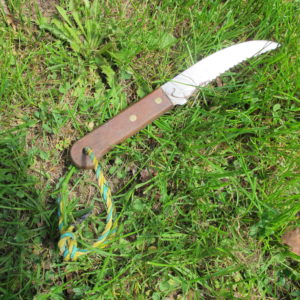
This knife has a serrated edge and is great for cutting back flower stems
Perennial weeds and grasses have serious roots that are hard to pull, and will survive the winter. If you can get them out now, you will have less work next spring. In the spring the soil will be wet, the air cold. We will still have some nice warm days for weeding before winter.
Use a good weeding tool to get all the roots out. I like the CobraHead weeder to tease out the roots and comb though the soil. It’s a simple hook that slides through the soil easily and lifts up scraps of root. You can suppress weeds in the spring by putting down old newspapers and covering them with straw or leaves.
Insect pests and fungal diseases can be minimized next year by getting rid of plants this fall. Tomatoes generally have at least some leaf blight, and squash family plants often have both insects and fungi by the end of the summer. Potato bugs may have visited your plants. So get rid of these plants by putting them in the household trash or by adding them to a pile of brush you will burn after snowfall. I suppose you could drag them off to a far corner of the property, but I know that potato bugs, at least, will hike a long way for a free lunch.
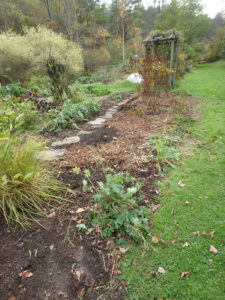
Most perennials were cut back in this bed
Clean up the flower garden. This entails cutting back most flowers and pulling weeds. I say cut back most flowers, but suggest leaving a few tall flowers for the birds – they like seeds of sunflowers, black-eyed Susans and purple coneflower, among others. Those tall plants also provide a little winter interest for you silhouetted against the snow.
Instead of cutting back your perennials with your pruners, try using a serrated knife. Next yard sale you see, stop and buy a steak knife. They work great. Grab a clump of stems and saw them off. I suppose one of those folding pruning saws would do it, too – but wear gloves and be careful using one. They are very sharp.
I’ve used hedge clippers, too, for fall cleanup, but often old clippers don’t do a good job on heavy stems; things get stuck between the blades. I have a pair that works well made by Barnel, their B1000L hedge shears. Available from www.oescoinc.com.
Should you rake the leaves out of your flower beds? That all depends. If you leave the leaves, they will help suppress weeds in the spring, and will eventually decompose. Still, many gardeners like the look of a clean flower bed. The choice is yours. Me? I generally leave them.
Another fall task involves improving the soil, particularly in the vegetable garden. Adding a layer of compost after weeding is always a good plan. Add an inch of more of compost and stir it in with a tool, and it will stimulate your soil to become more biologically active by adding and feeding soil microorganisms.
Many garden centers sell compost by the truckload for a price considerably more reasonable than by the bag. Dairy farms often sell aged manure or hot-composted manure (which is even better). Some will deliver it to your garden. If you keep your raised beds in place each year, just add the compost to the beds, don’t waste it on the walkways.
Fall is a great time to get your soil tested. Your state Extension Service offers this service, just go on-line and download the form. If you have never had soil tested, pay extra and get tested for heavy metals if you grow edibles. Houses built before 1978 (when lead was banned in paint) often have lead in the soil nearby – which is dangerous. A good soil test will not only tell you if your soil is deficient in minerals, it can tell you if it has adequate organic matter and a soil pH that works for your plants.
For a more in-depth soil test, you can do a test with Logan Labs (https://loganlabs.com/) and for a fee of $30, talk with a soil scientist about the results.

Mulch on a vegetable garden will keep down weeds in the spring
Last, rake the leaves, or better yet, chop them with the lawnmower and then rake them up. Chopped leaves are fantastic mulch, and a real boost to your soil. Earthworms love them, and will bring the organic matter down into the soil. When you cut the lawn at the end of the season, lower the blades a little because long grass is more susceptible to winter fungal problems.
There are plenty of other tasks to do in the garden, so play hooky on a sunny day and get back out into the garden. You’ll never regret doing so.
I now have pricing for the Viking River Cruise I hope to lead from Paris to Normandy and back next June 19 to 26. E-mail me for the details at henry.homeyer@comcast.net. This could be great fun, and I plan to do some gardening talks in the evenings.
7 Things to Do to Improve Your Garden – and Your Life!
Posted on Tuesday, June 18, 2019 · Leave a Comment
If you’re like me, by now you have your garden planted, both vegetables and flowers. It seems like a good time to take a deep breath, pour a cold glass of your favorite beverage and watch the flowers perform. I have set up chairs by my Japanese primroses for viewing, and have invited friends to come see them and relax. But wait! There is still a lot to do, and you can make your life easier with some work now. Here are 7 garden activities I recommend.
- Weeds in the vegetable garden are little now, and easy to pull. Take 20 minutes a day – or twice a day – and just weed. All my weed-free beds are sprouting weeds, but the roots are small. It’s important to loosen the soil a little before pulling weeds. If you don’t do that and you hear a snap, you have broken a root. I like a CobraHead weeder for loosening the soil because it has a single tine, and is very precise.
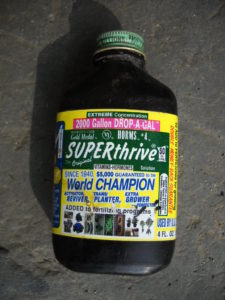
Superthrive is great for reducing transplant stress
If you are weeding in a bed with small seedlings – lettuce, for example – you may end up pulling up seedlings, too. Re-plant immediately, and water. I use an anti-stress liquid called Super Thrive, just a quarter teaspoon in a gallon of water, after weeding. It helps plants recover from having their roots disturbed. It has plant hormones and seaweed extracts, and I find it very effective.
- I like to mulch after weeding, and after the soil is nice and warm. If the soil is still cool and wet, wait for a few days of hot sun before mulching. Roots like to be warm.
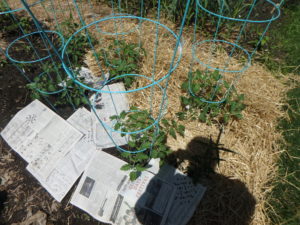
Mulching tomatoes with newspaper and straw
My preferred method of mulching is to put down several layers of newspapers around big plants like tomatoes, and in walkways. Then I cover it with straw, leaves I saved last fall, or even mulch hay. Mulch hay has seeds, but the newspaper keeps the seeds out of the soil pretty well. Leaves are the best, but always in short supply.
- Protect your tomatoes. Put tomato cages around them. They need to be kept upright, but will flop if you don’t support them. Get the 54-inch cages with 4 legs, not 3 legs. Tomato diseases are generally soil borne, so mulch the soil with grass clippings, leaves or straw to prevent splash-up.
This year I am trying an experiment with a biological control for blight on tomatoes. There is a bacterium, Bacterium subtilis, that feeds on fungi. It is now available as a commercial spray called Serenade. I have sprayed half my tomato plants with Serenade and marked them with labels. According to the directions, I will need to spray once a week. I will report back if I see a marked difference.
- Find and utilize unused spaces, both in the vegetable garden and flower beds. If you planted a few nice perennials this year, you probably left space for them when they get big. Instead of depending on mulch to fill the space, plant some annuals.
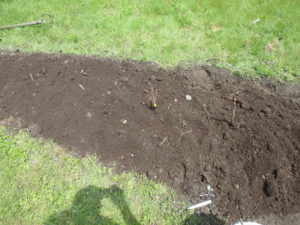
This newly plant raspberry patch has plenty of room for lettuce
The same works in the vegetable garden: Tomato plants won’t be big for another 4 to 6 weeks. Grow lettuce around them, and eat the lettuce before they get shaded out. Spinach and radishes are good candidates for those spaces, too.
- Think about cutting off branches of trees that are now shading out your gardens. Or remove trees altogether. I love my trees, but find they are interfering with my flowers and veggies that like full sun. I removed several large branches from a pear tree this winter because it was shading my peonies. You can do that now, too.
Weed trees like box elder and poplars should be the first to be removed. They pop up and get big before you know it. Elms will grow for 25 years or so, then die from Dutch elm disease, so I cut or yank those any time I find them on the property.
- Thin root crops like carrots, beets, rutabagas and parsnips. By the Fourth of July all those should be 1 to 2 inches apart. Carrots will compete with their brothers and sisters just like they do with weeds – and suffer.
- I don’t want to sound like Anne Landers, but get a gardening partner to help in the garden. It works for me! My life partner and sweetie, Cindy Heath, has lived 6 miles away for the past 10 years. But now she has moved in so we garden together here, instead of having 2 gardens.
If you already have a husband or wife, some re-training may be needed. Pavlov had it right: Make brownies or give back rubs as a reward for help in the garden. Soon there will be no more weeds!
Henry lives and gardens in Cornish Flat, NH. He is the author of 4 gardening books.
Tips for a Successful Vegetable Garden
Posted on Sunday, May 19, 2019 · Leave a Comment
Depending where you live – a cold hollow, a hilltop, or near a large body of water, you may be ready to start planting the vegetable garden – or not. In any case, there is much to do before your plants go in the ground. Here are some tips to consider. In my opinion, there is not much point in planting seeds or seedlings until the soil has warmed up sufficiently. A soil thermometer will tell you when it hits 60 degrees a few inches the soil surface; 60 degrees is good even for cold weather crops like spinach and peas, although you can plant them into cooler soil. Cold, wet soil may rot seeds and discourage seedlings.
Last fall I covered my garden with leaves and straw; I start work in the vegetable garden by raking those off. This will allow the soil to absorb the sun’s heat directly. If I’m in a hurry, sometimes I will cover a few rows with clear plastic and seal the edges with soil or mulch so the heat will build up.
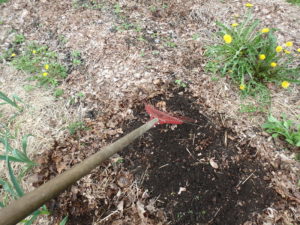
Its time to brake off the mulch over the vegetable garden to the soil can warm and dry out
On a sunny day it will get up over 100 degrees under clear plastic, which will also cook and kill many germinating weed seeds. It won’t kill perennial weeds or grasses, as the roots will survive even the hottest of days under plastic. Black plastic also holds in the heat, but is slightly less effective in heating the soil.
I don’t believe in rototilling, except perhaps when mixing in a thick layer of compost to a new bed, and even then I recommend a shallow tilling. Rototilling makes the garden look good, but it is not good at killing weeds. It just cuts up those perennial roots and spreads them around. Instead of having a hundred weeds, you can have a thousand. Soil organisms each have found the perfect place to live; stirring up the soil only disrupts their habitat.
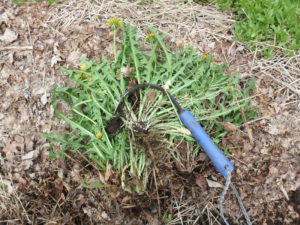
The CobraHead weeder loosened the soil allowing me to get the entire root
After raking off the mulch into the walkways, I weed. Yes, I weeded last fall. But I will have missed plenty of little ones, and others have germinated from seed by now. I like the CobraHead weeder best. This curved tool gets under weeds, loosens the roots, and lets me get the plant and its entire root system easily. Of course, you probably have a favorite tool and whatever works best for you is the right tool. CobraHead makes a long handled version, but I don’t mind bending over to weed.
Meanwhile, I have been hardening off my vegetable starts, and will continue to do so. Just as you would not put a baby in the sun without sunscreen, I won’t put my baby tomatoes out in the garden without preparation.
I start by putting out the flats of seedlings on a deck that only gets morning sun for a few days. Then I give them morning sun and a couple of hours of afternoon sun. After a few days of this, they are ready for all day sun. The stems have gotten stronger, the leaves are used to wind and sun, and they are ready to plant.
When do I plant? I planted spinach seedlings around May 8 or 10. Lettuce and kale seedlings are growing in my cold frame that warms up the soil and keeps them cozy at night. But my tomatoes? I wait well past the last chance for frost to plant. I also know that they will sulk – and stop growing – if the soil is too cold or if the nights too chilly. I have been carrying them inside at night during the hardening off process.
Plants that do well in cooler temperatures include the following: arugula, beets, broccoli, Brussels sprouts, cabbage, carrots, celeriac, kale, kohlrabi, lettuce, leeks, onions, parsley, peas, potatoes, radishes, rutabagas, spinach and Swiss chard. All the rest, especially sweet potatoes, tomatoes and all the vine crops can be seriously set back by chilly nights and killed by frost.
Now is a good time to plant some vine crops in small pots inside. I have a terrible time with the striped cucumber beetle. If I plant seeds outdoors, the beetles miraculously appear the night the seeds germinate and eat those first two little leaves. That kills the plant. But if I get vines 6 inches long with a few real leaves, the beetles can chew on the leaves, but won’t kill them. Cukes, squash, watermelon and pumpkins all are attractive to those nasty critters.
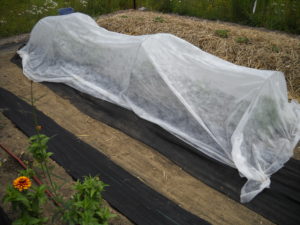
Row cover with hoops helps to keep insects off and keep plants warm
Another way of protecting crops from marauding insects and furry critters is to cover them with a thin agricultural fabric called row cover – also called Reemay or Agribon (trade names). This stuff will let sun through, as well as moisture and air. You can drape it right over the plants, or stretch it over wire hoops that are sold for the purpose. It comes in 5-foot wide rolls, which is perfect for a wide raised bed. You need to buy earth staples to pin it down. It comes in varying thickness; thick ones will keep things warmer, but allow less light to come through.
Later, when your cukes and squash start to flower, you need to take off the covers as insects pollinate the plants. Peppers and eggplants benefit from the extra heat contained by the row covers, and are wind pollinated. Generally they do fine under row cover.
One last piece of advice: ask at the greenhouse if the seedlings you are buying have been hardened off. Being inside a greenhouse is much less stressful than being outside directly in the sun. Leaves can actually get sunburned if not hardened off outside. They will recover, but slowly. So you may need to harden them off before planting.
Memorial Day weekend is the traditional day for planting warm weather crops in my area. But I never hesitate to wait a bit longer. The plants will always catch up.
Write Henry at PO Box 364, Cornish Flat, NH 03746 or e-mail henry.homeyer@comcast.net.
Holiday Gifts for the Gardener
Posted on Monday, November 20, 2017 · Leave a Comment
By the time you read this, Black Friday will have passed us by. I know that some people stand in line that day, starting before the sun comes up to get special deals on electronic games and various widgets, but I have never done so. And won’t. My love ones get good, practical presents that will last. Here are my ideas for gardeners to give – or get.
Actually, not all my presents will last. Some are edible presents. Each year, for example, I dehydrate cherry tomatoes, apples, pears and hot peppers. A pint bag of dried cherry tomatoes represents a lot of work – and love. First I had to start the seeds and raise the seedlings. Then plant, stake and weed the plants. Harvest when ripe, cut in half, dry for 18 hours or more, and then bag them up. A pint of these babies is about 240 dried cherry tomato halves. A delectable gift.
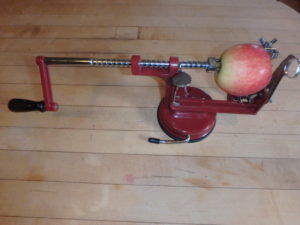
Apple Tool
Dried apples and pears are easier presents. I have a kitchen tool that will peel, core and slice apples and pears. You skewer the apple, turn a crank, and it’s ready to use in a jiffy. Much less time consuming than cutting cherry tomatoes in half and arranging on a tray. And of course, a few dried apples will fill up a quart bag, and a good tree will last a lifetime. The slicer I have is called the Triple-Action Apple Machine and it’s available from King Arthur Flour (www.king arthurflour.com) for about $25.
As to the dehydrators, those are serious presents. I have 2 kinds, and like both. The Cadillac of dryers is the Excalibur. Mine has 9 trays, a timer and a thermostat. The hot air blows across the trays, so all dry in equal time. Mine, Model 3926T sells for around $300 (www.excaliburdehydrator.com).
For a more economical price you can get a NESCO American Harvester dehydrator. They come with heat and blowing units either on the top of the bottom of a stack of trays. Those closest to the heat dry first, so you have to keep checking them and moving trays around. But they only cost $130 to $150 from the manufacturer. (www.nesco.com). I like the dehydrator with bottom heat best. But they take longer and use more electricity than the Excalibur (1000 watts per hour of use versus 660 watts per hour for the Excalibur).
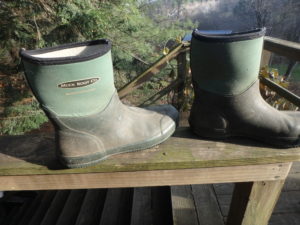
Muck Boots
I spend a lot of time working outside when the grass is wet or paths are muddy. I like dry feet, and nothing compares with my Muck brand boots. I’ve had them for over 10 years, wear them nearly every day in spring and fall, and they are not even thinking of wearing out. Mine are 10 inch high slip-ons, green, insulated. Warm. Looking on line, I think it is called the scrub boot. They cost $60-70 a pair. Of course I bought mine on sale for less.
At this time of year I’m battling mice and squirrels that want to get in the house to find food and lodging. My old house has a stone foundation, so it lets them in, here and there. Recently I got something called, “Mice Magic” from Gardeners Supply (www.gardeners.com) which claims to repel them – avoiding the need for trapping them.
Mice Magic comes in sachets like tea bags that are very fragrant – with spearmint and peppermint. Each lasts, it says, for 30 days. And one only needs one in a room to discourage the mice. So I have them in my basement and in the attic storage areas that tend to accumulate rodents. So far, they seem to be doing a good job, and these would be good presents. A box of a dozen (item # # 8592441) costs $29.95.
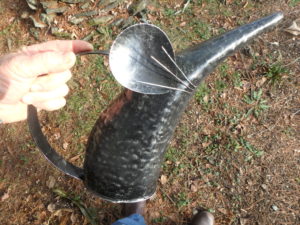
Mouse Watering Can
Speaking of mice, I recently got a watering can shaped like a mouse – complete with ears and whiskers! This is a metal watering can for indoor plants that makes me smile every time I use it. It pours nicely and holds a nice amount of water. Available from Gardeners Supply for $19.99. (item # 38-315)
Every Christmas when I write this column I mention tools, including the CobraHead weeder. This is, simply, the best weeder in America. It’s a single-tined weeder shaped like a bent finger – or a rising cobra. It can get under weeds and grasses, and tease them out. Available at garden centers everywhere and most seed companies, it is also available on line at www.CobraHead.com for $24.95.
Other tools I’d recommend? A collapsible rake. These can be adjusted to open widely, to 24 inches, or closed down to just 8 to 12 inches. There are several brands, and prices range from under $10 to about $25. All metal.
Books are great for gardeners, too. This fall I attended a lecture by Thomas Rainer and bought his book, Planting in a Post-Wild World: Designing Plant Communities for Resilient Landscapes, co-authored by Claudia West. It’s an interesting read, presents many provocative ideas, particularly for urban and suburban gardeners. They explain, for example, that we often plant gardens with plants that would never be together in the wild – they have entirely different needs for sun, water, pH – and we could do better planting those that have similar requirements. (Timber Press, $39.95).
Last winter I attended a talk by Celeste Longacre and bought her self-published book, Celeste’s Garden Delights: Discover the Many Ways a Garden Can Nurture You (available for $25 at www.celestelongacre.com). It’s a nice book that not only gives tips for growing vegetables, but also for storing and using them. I got some good tips from it, including a better way to store beets.
So Santa, I don’t really need anything this Christmas, but if you want to drop off a load of reindeer droppings, they’d be great for my compost pile.
You may reach Henry at henry.homeyer@comcast.net or by mail at PO Box 364, Cornish Flat, NH 93746. Please include a SASE if you want a response by mail. Read his blog at https://dailyuv.com/gardeningguy.
Putting the Garden to Bed
Posted on Tuesday, September 26, 2017 · Leave a Comment
Early autumn is a great time to work in the garden, and it’s not too early to start putting your garden to bed. I can work early in the morning without layers of wool, and my hands don’t need gloves to stay warm. Too often we gardeners wait until later, when frost is on the garden, to clean up. Start now, do a little each day, and the job will not be onerous.
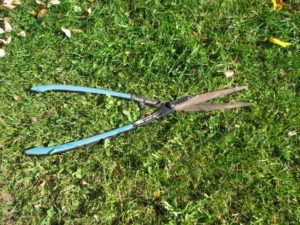
Hedge shears
Start by removing anything that is ugly. Your bleeding hearts (Dicentra spectablilis) has foliage that is yellow and has collapsed. Cut it out! Peonies may have dark blotches on the leaves – a potential sign of a fungal disease called botrytis – and should be removed.
Anything that looks like it is diseased should not go in the compost pile, but in the household trash or on a burn pile for winter. Be sure to cut right to the ground when removing foliage. Yes, you have to bend down a little lower, but the close to the ground, the better. That way you will be more likely to remove any diseased portions, and it will look better in the spring.
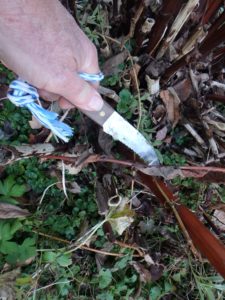
Serrated knife is good for cutting down flower stems
I know many gardeners like hand pruners to remove foliage, but I find that a bit tedious. I like a serrated knife. I hold a handful of tops, and with one swipe of my knife I cut through it all. The same group of stems might take a dozen snips. I’m all for speed and efficiency when working in the garden.
Other techniques? Hedge shears will make quick work of a big clump of iris leaves. But make sure they are sharp. Modern electric hedge clippers work, too, but I have been known to cut off the cord. Be sure to plug into one of those special outlets with reset buttons (GFCI) if you using electric hedge clippers – they’ll save you from getting electrocuted!
I have one 50 foot bed that is 8 to 10 feet wide. I call it my Darwin bed, as plants compete for space. No weeding. It’s full of tall plants like Joe Pye weed, turtlehead, phlox and more (including goldenrod for the pollinators). In late October, but before snow, I will run over the entire bed with a riding lawn mower, blade all the way up, engine racing at full throttle. It works!
You may wish to leave some flowers for the birds. Nice seed pods on purple cone flowers and black-eyed Susans will please the finches in winter, and look great above a thin layer of snow. Decorative grasses will sway in the winter wind, and look good for at least a month or two. You can always clean them up in the spring, or during a winter thaw if so inclined (and wearing wool).
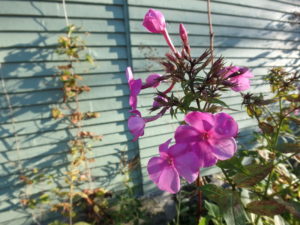
Phlox in November
As you cut back your perennials you will notice some volunteer plants. Phlox is forever planting itself around my garden, as is great blue lobelia and (dis-) obedient plant. It is natural to say, “Oh, how nice, the phlox is spreading.” But do I really want more phlox? NO, if I did want more, I would have planted more. I’d really like a new color, not more of the same. So I’ll dig it up and put it at the end of the driveway in a throwaway plastic pot. “FREE” will stop traffic.
As you cut back, weed! That will require different body motions – and fewer aches and pains. You probably already know some weeds by name, and by root. Some are perennials or biennials with deep tap roots. Others have lateral roots with nodes that send up more weeds. Annual weeds pull up with little effort and have small roots – but thousands of seeds. Try not to shake out seeds from weeds that have bloomed and set seeds. They will be back to annoy you for years to come.
I bring 2 tools with me for weeding: a garden fork and a CobraHead weeder. The fork is great for deep-rooted weeds. I plunge it in or step on it to force it into hard soil, then tip it back, loosening the soil. The weed, along with the deep root, will come right out, particularly if the soil is moist.
The CobraHead weeder has a single curved tine with a widened tip. It has become an essential tool for me; it’s like a curved finger. I use it to get under a weed. It allows me to lift and loosen soil beneath a weed while I tug on the top. If there are lateral roots, I tease them out, tugging and loosening until I have the entire darn thing.
Nothing beats crawling on your hands and knees for finding weeds. You are at their level. But if it’s hard for you to get back up, maybe you’d like to sit on something, particularly if the soil is cold and wet. I sometimes use a 5-gallon pail, but have seen some nice kneeling seats designed for gardeners, and have heard nice things about them. But to each her own.
Mulching? That can be the last step of fall clean up. Finely ground bark mulch or chipped leaves can be good for keeping down weeds, but don’t use too much. And try to keep it back from the crown, or center growing area of the plant. You can ruin peony’s ability to bloom by covering it with 3 inches of bark mulch. And avoid buying bagged mulch that is “color enhanced”. It has chemicals in it.
Me? I like flower gardens that have big clumps of perennials and lots of groundcover plants to cover bare spaces. That’s what Mother Nature does. I don’t like big swaths of bark mulch, though I use some in newer beds.
So go get to work on a nice day. It will save you time in the Spring.
Read Henry’s blog posts at https://dailyuv.com/gardeningguy You may e-mail him at henry.homeyer@comcast.net.
Holiday Gifts for the Gardener
Posted on Wednesday, November 30, 2016 · Leave a Comment
It’s that time of the year again: time to figure out good gifts for Uncle Albert and your sister Sadie. If they’re gardeners, gifts are easy to pick. There are plenty of items that cost from $5 to $300, and generally, one size fits all. Let’s look at some things I have used and like.
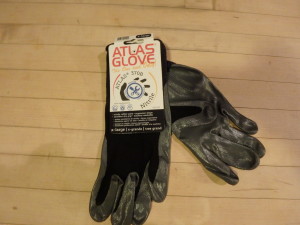
Nitrile Gloves
After giving a talk at the Milford, NH Garden Club recently, I bought some gardening gloves that were being sold as a fund raiser. These cost me just $5, and have already earned their keep. These are nitrile gloves made by the Atlas Glove Company. They have a waterproof palm and a stretchy, breathable fabric back. I have big hands, and the x-large size was perfect. Mine are black with silver palms, but the smaller sizes come in a variety of colors.
I don’t generally wear gloves when gardening, as most are too thick – and I like the feel of the soil – but in cold weather I do wear them. These are thin enough that I can go easily in my pants pocket and pull out my pocket knife, or feel a tender weed. The nitrile glove is the Atlas 370B series. I’ve also used a thicker Atlas glove with a natural rubber palm, the 300 series. These are both available at most gardening centers.
Does your loved one start plants by seed? Gift cards at garden centers or seed companies are nice. I get my seeds from several places: the Hudson Valley Seed Library, Johnny’s Selected Seeds, High Mowing Seeds, Renees Garden and a young company in New York State, Fruition Seeds. All have wonderful selections.
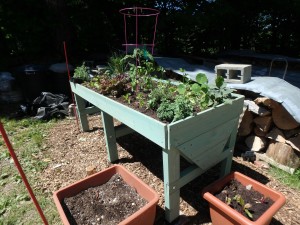
VegTrug
One of my favorite additions to my garden this year was a “VegTrug” from Gardener’s Supply Co. (www.gardeners.com, Item#8586918). This is a stained cedar planting box on legs, about 6 feet long and 32 inches wide that retails for $279, with free shipping. It is V-shaped in cross section with the deepest portion 16 inches deep – deep enough for potatoes or tomatoes. It stands 32 inches tall, so no bending is needed to weed or to pick.
In my VegTrug I grew one patio tomato and pretty much every kind of herb: basil, dill, marjoram, thyme, sage, purple sage, chives, oregano and parsley. I even had a nasturtium cascading over one end.
One reason I loved my VegTrug was the convenience: it allowed me to have herbs near the house in a spot not otherwise suitable for growing. And the plants grew well, although in the heat of the summer they dried out more quickly than my garden near the stream, so I watered pretty much every sunny day. It uses 380 liters of soil mix, so I made my own, a 50-50 mix of peat moss and compost. The bottom is slotted for drainage, but it comes with a woven liner to prevent soil from washing away.
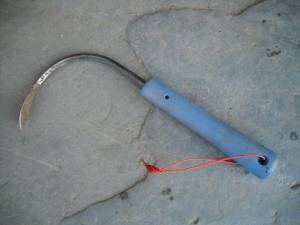
Cobrahead
Every gardener needs a good weeding tool, and every year I recommend the CobraHead Weeder, because I believe it is the best weeding tool available. This tool has a single tine that is curved like the shape of a rising Cobra. I use it to tease out grass roots, to get under large weeds (so I can loosen the soil below them and pull from both top and bottom of the weed at the same time), and for preparing soil to plant. Now it seems a part of my right hand (though it is right-left neutral). At under $25 locally or from the manufacturer (a family business found at www.CobraHead.com), this tool is tough, strong, and made in the USA.
Every year I try to learn more about growing healthy plants. This year I paid $50 to join the Bionutrient Food Association (http://bionutrient.org/), and would like to suggest giving a membership as a nice present. One of the goals of the non-profit is to educate members about how to grow food that is nutrient-rich.
Much commercial agriculture depends on adding just 3 minerals to the soil (nitrogen, phosphorus and potassium) and basically ignoring the other nutrients that plants – and humans – need to be healthy. Growing vegetables year after year removes micronutrients from the soil that need to be replaced. The BFA offers information and workshops that I believe will help me to grow better food and stay healthy.
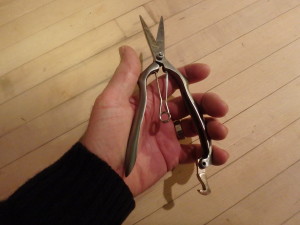
Garden Shears
Weeds are the bane of many gardeners. One way to minimize their presence is to weed daily, mulch, or to put down weed mats. A Vermont company, Garden Mats (https://gardenmats.com) produces heavy-duty woven mats with pre-cut holes in a variety of patterns for different vegetables. I’ve used them – and re-used them. They keep down weeds, hold in some moisture, but also breathe and let rain penetrate. They are 4 feet wide and come in lengths of 6, 12 and 18-feet for a cost of $11 to $31. They are definitely a labor-saver, and they claim the mats increase yields 10% to 20%, too. I like them, and also the fact that it is a small, family-owned business.
The last item for this year’s list is a lovely pair of stainless-steel garden shears for cutting flowers, herbs, and for use in the kitchen. Made in England, these shears are elegant as well as sturdy, and are said to be designed for small hands. Sold by Gardeners Supply (Item#8593404), they retail for $60 and come in a handsome gift box.
Santa, if you’re listening, I have everything I need. So you can just volunteer to come work in my garden next summer. I know it’s the off-season for you, and we both need to lose some weight, anyhow. We can pull weeds and eat cukes.
Read Henry’s blog at https://dailyuv.com/gardeningguy. You can get an email update every time he posts.
Weeding
Posted on Wednesday, June 17, 2015 · Leave a Comment
I love weeding. It creates order out of chaos, something I have come to appreciate. An un-weeded flower bed is full of distractions. My brain is constantly instant messaging me: “See that dandelion? You should pull it”. The weeds distract me from the beauty of the flowers and the texture and color of the leaves. I feel better as soon as I get my weeds pulled. That said, I still have weeds. Maybe I need to retire from writing a column!
Weeding also makes my plants thrive. Weeds compete with vegetables and flowers for sunshine, moisture, nitrogen and micro-nutrients. In the early spring when my perennials are just waking up, I am very careful not to yank their little green sprouts, thinking they are weeds. In fact, I often let some of my weeding go until late May or even mid-June when everything is obvious.
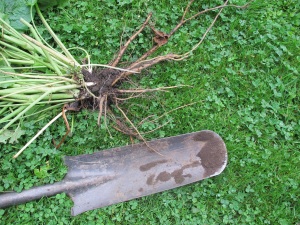
Drain spade and burdock roots it dug
Dandelions, weeds that I don’t mind in the lawn, can get a bit rambunctious in the garden beds, and I pull them without compunction. Because they have a deep taproot, they are best pulled when the soil is moist. I use a long narrow shovel, one sold as a “drain spade” to loosen the soil down 12 to 16 inches. This spade is just 6 inches wide but the blade is16 inches long. I push the blade deep into the soil, pull back a little, then push it forward, and then slowly pull out the weed, the slower the better.
Sometimes I see a little dandelion and just grab it and pull – only to have the top break off while the roots remain. Whenever you leave dandelion roots, or even fragments of root, the plant will grow back.
Burdock and thistles also have tap roots, some going down very deep. The older the weed, the deeper the root. I’ve pulled mature burdock plants with roots nearly two feet deep. This is only possible when the soil is moist.
It’s really critical, especially for any weed that produces lots of seeds, that you not let them flower. If you don’t have time to dig them out, at least snip off the flowers. Many weeds have green flowers, and some will produce seeds even after being pulled if they have already formed flowers. I don’t throw noxious weeds, things like goutweed, in the compost pile for fear they will grow and spread – or leave seeds.
My favorite weeding tool is the CobraHead weeder (www.CobraHead.com). This is shaped like a tine on farmer’s cultivator – or a bent steel finger. I like it because it is narrow in profile and curved in a way that allows me to easily get the blade under the roots of a weed. I pull from below with the CobraHead while pulling the tops from above. I drag it through the soil in a bed after weeding and am always surprised by now many fragments of root it brings to the surface. I can use it with one hand or two. I use it for loosening the soil while planting, too. It is neither right- or left-handed, it is lightweight, and the handle is made from re-cycled plastic.
The CobraHead is great for teasing out long roots, too. I once pulled out a root 39 inches long in one piece, just gently loosening with the tool while tugging on the weed. That root was from a Queen of the Prairie (Filipendula rubra), a lovely pink-flowered perennial thug. It’s great for teasing out roots of invasive grasses.
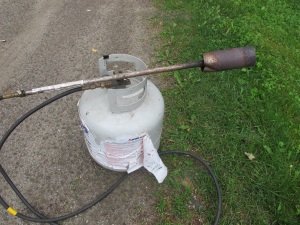
Flame weeder
Another great weeding tool is a favorite of my comic hero, Calvin, of Calvin and Hobbes. I refer to my flame thrower. It is technically a flame weeder, but Calvin and I refer to it as a flame thrower. It’s a metal wand on a 10-foot rubber hose attached to a propane tank normally used for gas grills. Light it, and it sends a flame out of the nozzle that will turn any weed crispy in an instant.
I often use my flame weeder on freshly turned soil. I let weed seeds germinate for a week or more, then burn them off before I plant. I try not to disturb the flamed soil when planting, as seeds that have been buried deeply will not germinate, but those on the surface, or near the surface will. Many weeds have what I call a photo-trigger. No light? They won’t germinate. Or I will flame, then plant seeds, then flame again before my carrots are up. Available from Johnny’s Selected Seeds or Fedco Seeds.
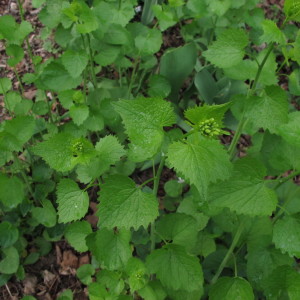
Garlic mustard leaves
One of the worst weeds in the world is garlic mustard. Not only will it outcompete other plants in the understory, it can grow in full sun to full shade, and can produce many tens of thousands of seeds per square yard. Garlic mustard is also allelopathic, meaning that it produces chemicals that inhibit the growth of other plants and mycorrhizal fungi needed for healthy tree growth and tree seedling survival.
A friend last year hired a guy to pull all the garlic mustard under her trees and shrubs. It pulls easily, and he quickly filled wheelbarrows full of mature plants. But this year there were thousands of tiny garlic mustard seedlings popping up all over, even in the bark mulch he had put down. I lent him my flame weeder, and in no time he had burned off the small plants.
Many weeds can be deterred by a good thick layer of mulch. Seeds don’t germinate, or seedlings can’t push through the mulch, particularly if you lay down 4-6 sheets newspaper before mulching. Other, aggressive weeds will. Mature Japanese knotweed roots have been said to push through an asphalt driveway! Still, most garden weeds are really just enthusiastic plants that want to be your friends! My practice is to pull weeds every day, and that way I hope to finally beat them. Hah!
Henry is a garden writer, public speaker and garden consultant. He lives in Cornish Flat, NH. You may reach him at henry.homeyer@comcast.net.
Lessons from an Asparagus Patch
Posted on Wednesday, May 7, 2014 · Leave a Comment
On a recent cold, gray Sunday I was looking for a good project to do in my garden. I decided to clean up my asparagus bed and get rid of last summer’s dead stalks and those sneaky weeds that had avoided my lethal grip. I had planted a new asparagus patch in 2012, so this is the first year that I can harvest a few stalks – and I can’t wait. I want to give my asparagus every advantage.
First, some basic information about asparagus. It is a perennial vegetable that, well tended, can produce for 25 years or more. It often grows in the wild, especially along roadsides where it competes with grasses and weeds. But in the garden it’s a fussbudget and won’t do well unless kept well weeded. In the wild it is known to grow in marshy places, too, but domesticated asparagus prefers well drained soil – but not dry soil. And full sun is best.
Asparagus roots radiate out from the center of the plant, and can be quite near the surface. When weeding it’s important not to disturb the roots, and to recognize them and cover them up if you expose them. The roots are brown and can be the diameter of a pencil lead near the tips, to the diameter of a pencil itself near the center of the plant.
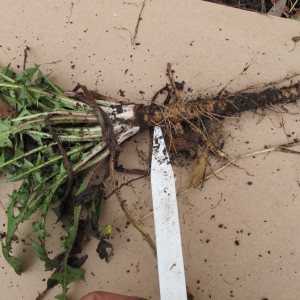
Dandelion. pointer shows where to grab it to pull out
I use a CobraHead Weeder which I like a lot. It is a single-tined weeder that works like a curved steel finger. It allows me to get at weed roots without disturbing the asparagus roots. In my bed I had a fair number of dandelions. I pushed my weeder into the soil about 4 to 6 inches, and then dragged it toward me on one side of the dandelion and then on the other side. That loosened up the soil without breaking off its deep tap root which resembles a scrawny carrot.
Next I grabbed the dandelion below the crown and applied gentle upward pressure so that I would not snap off the root. As with most perennial weeds, a morsel of the root left in the ground will grow and start over again. Most every time I got the entire root system.
Grasses, particularly witch grass, can be a real problem in the garden, and I had a little in my asparagus patch, though not a lot. Witch grass spreads by rhizomes, or roots that extend laterally. I get under the grass with my curved tool, apply some pressure from below at the same time lifting from above. Gently, so as to avoid breaking the white roots. Then, as the grass comes out, I am able to see where the roots are going, and tease them out, loosening the soil with my CobraHead and lifting. I often got roots that were 18 inches long or more. The roots have nodules where more grass leaves grow, so if you break off a root at a nodule, the plant continues to grow.
The ground was still quite wet when I was weeding my asparagus patch, so I stayed out of the bed itself as stepping in it would compress the soil and might damage roots. I brought along a kneeling pad – a simple foam pad – that kept my knees dry and protected them from sharp rocks. Some gardeners like kneepads for that function, but I’ve never found them terribly comfortable.
I plan to add 3 to 4 inches of compost over my asparagus bed, but first I want any weed seeds or broken bits of root to send up their new growth. I will remove those weeds, and then apply compost and a layer of mulch. We need some warm sun to get the weeds growing.
For mulch I use wood chips that I get from a local arborist by the truckload. They are free and easy to spread. I’ll wait until the soil has dried out and the tender asparagus shoots are poking up. I leave a little ring around the location of each plant to make life easier for my asparagus.
I know a fellow who bought a nice house with a mature asparagus patch. He loved asparagus and delighted in his free daily dose of it. But he wouldn’t stop picking, despite my warnings. For a young patch, pick for a month. For a healthy mature patch, six weeks is good. But never pick for more than 8 weeks. Asparagus needs plenty of time to re-charge its batteries, if you will. The fronds are actually leaves, and they need time to produce the food necessary for the roots to thrive. But he kept on picking long past the 8 weeks, and the next year he barely got a crop.
One last thought: if you are buying asparagus roots to plant, pick a variety that produces all male plants. The ‘Jersey’ series is all male, but the ‘Martha Washington’ roots are not – they will produce seeds, which is a waste of energy, and will produce lots of babies that will crowd your mature plants.
Henry Homeyer can be reached at henry.homeyer@comcast.net. His Web site is www.Gardening-Guy.com. He is the author of 4 gardening books and Wobar and the Quest for the Magic Calumet, a children’s fantasy adventure.
Holiday Gifts for the Gardener
Posted on Wednesday, November 27, 2013 · Leave a Comment
When I was a boy I believed in Santa Claus long after most other kids had given up on him. I must have been in fifth grade before I started to doubt the story of the jolly old elf. I’m not sure if that was due to my own personality, or because my parents and older sister deluded me. Or maybe I was just plain dumb, back then. But now, as the holidays approach, I try to choose gifts that only the real Santa would know are perfect. For gardeners, it’s easy.
Every Gardener needs some basics: a good weeding tool, a pair of hand pruners and a transplant shovel. For me, the weeding tool is a no-brainer: virtually anyone who has tried a CobraHead weeder (www.CobraHead.com) agrees that it is perfect. It’s precise, light-weight and is fabulous at teasing out long roots. Curved like the tine of an old-fashioned horse-drawn cultivator, I think of it as a steel finger. Available at good gardener centers everywhere, or from the company on-line for less than $25. And it will last forever.
Pruners and loppers are great gifts, too. Most of us –by my age at least – tend to misplace pruners, so even if your loved one has a pair, a second is always a great gift. And they get dull, so a new pair of sharp ones is a treat. Don’t go to a big box store and buy the cheapest you can. Buy quality pruners even though they can cost in excess of $50. The two brands I like are Bahco and Felco. Both are excellent. They come in different sizes for different size hands, so talk to a knowledgeable sales person. I personally do not like those with rotating grips that allegedly prevent carpal tunal.
I’ve had a pair of loppers made by Fiskars for at least 10 years that still work great – I use them a lot, even on large diameter branches. They are geared, so they don’t take great strength to use – and they never get “sprung” the way so many loppers do. Mine is the PowerGear 32” lopper, rated to cut branches up to 2 inches in diameter. Available locally for a little under $50. They also come in smaller sizes. All are lightweight and of good quality steel.
Transplant shovels are often overlooked by gardeners, but they do a much better job at moving plants than an ordinary shovel, so everyone should have one. I got mine at my local hardware store –LaValleys – where it is called a drain spade. Not sure why. The blade is long and narrow – 15 inches long and just 6 inches wide. I like the long blade for getting under the middle of a perennial and prying the plant loose after a few judicious probes. At less than $20, even Santas on a budget would approve.
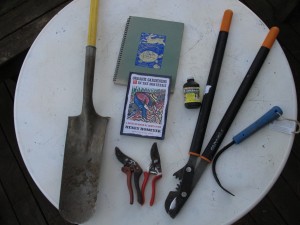
Holiday gifts
At the lower end of the cost spectrum are plants. I don’t advocate giving anyone a house plant -that’s too much like giving a puppy. Most gardeners have enough –nay, too many – house plants. But an amaryllis bulb is a good gift. They bloom, and then you can either throw it away or hold on to it and coax it to bloom another year (though that’s often more trouble than it’s worth). Prices range from grocery store amaryllis under $8 to fancy ones already potted up and ready to bloom at a florist shop for $15 or more. The bigger the bulb, the more expensive – and the bigger and more dramatic the blossoms.
Also around $10 would be a small bottle of Super Thrive. This is a seaweed and plant hormone extract that is great for helping stressed plants. And right now, many house plants are stressed due to the short days and lack of light. I find it helps them, and I also use it on transplants in the spring. Available locally.
A good blank book with quality paper is a nice gift if your loved one likes record keeping. It’s great to be able to look back, 5years later, and know the name of the variety of bulbs or daylilies you planted. Such a book is also good for sketches of the garden.
On the other end of the cost scale would be a nice dehydrator. I wrote recently about the Excalibur 9-tray dryer for fruits and veggies (www.excaliburdehydrator.com). It’s about a $300 present, so think of it as an investment: it’s an energy–efficient dryer for your tomatoes and apples and more.
Books are excellent presents, too. Santa, are you listening? I want Michael Dirr’s Encyclopedia of Trees and Shrubs. I know it’s expensive ($79.95), Santa, but it has 952 pages and 3530 color photos. It’s the new bible for woody plants by my favorite, highly opinionated tree expert. He even wrote a nice blurb for the back jacket of my last gardening book (Organic Gardening (not just) in the Northeast, A Hands-on, Month-by-Month Guide –just $17.50 in paper). And if you want us to keep on believing, we have to get the goodies. And I’ve been good this year!
Henry, a.k.a. Santa’s Helper, can be reached at the North Pole, P.O. Box 364, Cornish Flat, NH 03746 or henry.homeyer@comcast.net. Like Santa, he makes no promises except for his gardening book, which he can send you signed and personalized.
Holiday Gifts for the Gardener
Posted on Wednesday, December 7, 2011 · Leave a Comment
Gardeners are easy to shop for. We all need the practical (rubber-palmed stretchy garden gloves, watering wands, garden scissors, plant labels) and appreciate the whimsical (a nice garden gnome to surprise the grandkids). Gardening books keep us occupied during the long winter nights, and garden tools keep us dreaming of perfect peonies. Here are some suggestions for the gardener you love.
This year I discovered Tubtrugs. They are multipurpose, brightly colored, somewhat flexible containers made of food grade plastic that I like to fill up with weeds. I also use them when harvesting veggies or carrying hand tools; you can fill one with water to soak a dry potted plant or wash a small dog. They are easy to carry – handholds are built in. They come in 4 sizes from about 4 gallons to about 20 gallons. I have the 2 smaller sizes, which cost $11-14. Available at your local garden center or from www.tubtrugs.com.
As much as I don’t like plastic, I found another plastic product that is very handy: an Oxo brand watering can. As with other Oxo products, I find it not only functional, but handsome – and these come in a variety of colors. I like that the spout lets you see the water level inside when filling it up, and it rotates for storage (snuggling up, sort of, against the reservoir). The rose, which breaks the stream of water into a spray, is very fine for watering delicate plants, but I often just pull that off and water directly from the slender spout. They come in 2 sizes: 2 gallon ($28) and an indoor model that is just 3 quarts ($18). Available locally or on line.
Each year I have to tout my favorite weeding tool, the CobraHead Weeder, as it works so darn well, and I have met so many gardeners that just love it. It is a single piece of steel with a small, eye-shapede head and a curved handle. It has a nice bright blue, recycled plastic handle. It gets under weeds to pull from below while I tug on the topside; I use it when planting, too, stirring up the soil and teasing out grass roots. I like that it serves lefties as well as righties, and is light enough to please elderly weeders as well as big lunks like me. Cost? About $25. Available locally or at www.cobrahead.com or 1-866-962-6272.
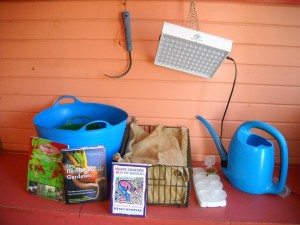
Holiday Gifts for the Gardener
Books help get gardeners through the winter. We read and plan when we can’t weed and plant. I recently got a very handsome, glossy-photo book by Jeremy and Emily Gettle, co-owners of Baker Creek Heirloom Seeds. He is quite a character – he started at age 3 and was growing 2 acres of vegetables by age 18. He started his own seed company when he was just 22 years old and now 33, he has quite a large operation – and a book.
The book, The Heirloom Life Gardener: the Baker Creek Way of Growing Your Own Food Easily and Naturally, is interesting and full of personal stories and anecdotes by Jeremy. He is opinionated, which I like, too. Best of all, it has a directory of garden vegetables that not only tells you how he grows them, but guides you to save your own seeds. It’s $30 in hardcover.
Another book I like is Ancestral Plants: A Primitive Skills Guide to Important Edible, Medicinal and Useful Plants of the Northeast by Arthur Haines. This is a fascinating technical book for survivalists, among others. It tells you not only about edible and medicinal plants, but which ones to use for making your own rope or are useful when starting a fire without matches. Haines is young (forty-one), and a serious scholar, having just written a 1,000 page taxonomy of plants.
Haine’s book gives information available in no other book I have found. So, for example, he tells you to eat eastern prickly gooseberries one at a time so that the crushing of the berry is done with teeth, not the palate (to avoid the prickles), and that it is high in Vitamin C, antioxidants and pectin so it can easily be made into jam. Each plant has at least 2 excellent color photos and 2 pages of text. $23 in paper available locally, or from www.anaskimin.org.
Each year I find some nice products from Gardeners Supply Company in Burlington, VT (www.gardeners.com or 888-833-1412). This year I like their pesto storage cubes for freezing pesto or tomato paste. They have attached lids, and fit into trays for storage. At $7.95 for 8 cubes they are a good gift. I also like their Root Storage Bin which costs $34.95. It is a sturdy wire bin lined with jute fabric designed to hold carrots, beets etc. in a cool dark cellar. It allows you to layer moist sand in it, keeping the veggies from drying out. It fits in a fridge I use for storing veggies. They also sell the Tubtrugs mentioned above. Since Gardeners Supply is an employee-owned company that supports lots of good causes, I enjoy supporting them, too.
I’ve been using LED lights this fall to pamper my houseplants, and I find my plants are much healthier this year. Best of all, for 42 watts of electricity I am getting the equivalent of 250 watts of light, and the spectrum of light, the company says, is just right for making plants happy. I got mine from Sunshine Systems (www.sunshine-systems.com or 866-576-5868). Each unit costs about $150 and is suitable for illuminating 5 square feet of plant space. The lights are designed to let you connect several together, which is handy.
Lastly, as an author I would be remiss if I didn’t mention my own new book: Organic Gardening (Not Just) in the Northeast: A Hands-On, Month-by-Month Guide (Bunker Hill Publishing). It’s a collection of my best writings from the past 10 years, organized around the calendar year. It’s $17.50 from your local bookstore or from my website (www.Gardening-guy.com).
So give Santa a hand. Go get something nice for the gardener in your family. And remember to try buying local first: local bookstores, local garden centers – only buy on the Web as a last resort! And Happy Holidays to you all.
Henry Homeyer is the author of 4 gardening books. His Web site is www.Gardening-guy.com.



























